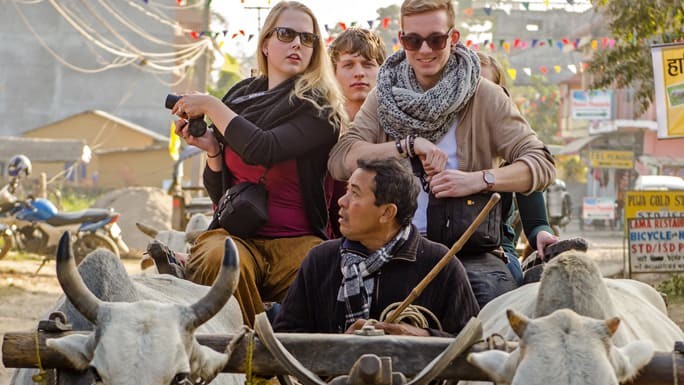-
Places to go
-
Things to do
-
Adventure
Nature
Culture
Wellness
Others
-
-
Festivals & Events
-
Festivals
Event Calendar
-
-
Plan Your Trip
-
Trip Ideas
Travel Details
Book Your Trip
-
- Travel Updates
Cultural Tours
Cultural Tours
Take a cultural tour in Ktm Valley or take an ox cart village tour in the Tarai region to discover the real Nepal.
Nepal is a melting pot of many cultures and religions all co-existing in perfect harmony. Take a cultural tour in the Kathmandu Valley to discover the founders of the valley civilization, the Newars who even today occupy central Kathmandu which was the original city. Or take an ox cart village tour in the Tarai region to truly discover how diverse the population of Nepal really is.
The valley's pleasant climate and safety from floods and other natural disasters complemented by the fertile soil attracted invaders to conquer and settle here. Various, mighty dynasties ruled Nepal through many centuries and brought together diverse cultures and religions that thrive to this day.

Depending on where you travel within Nepal, you will encounter people of various ethnic groups. The general distribution goes like this: there are Newars in Kathmandu valley mixed with many different ethnic groups that migrated here. In the lower hills live the Brahmins and Chettris along with many others. As you climb higher, you encounter Tamangs who generally live along the hilltops. Further up in the mountainous region where it snows live the Sherpas who have adapted to the high altitude. The group known as Kirants live in the east also in the hilly and mountainous regions. There are many other groups spread around like the Magars and Gurungs. Religions vary from Hindu to Buddhist, to animists, to Christians and Muslims. The tribes living in the higher regions are generally Buddhist.
Nepal is divided into three layers, according to its geographical settings - Himalayan region, Mid-hills, and Tarai region (flat plains). Himalayan region is the home of the legendary Sherpas, who are renowned for climbing Mt. Everest. and many other peaks.
One of the first mountaineers to climb Mt. Everest was Tenzing Norgay along with Edmund Hillary from New Zealand. Sherpas follow Tibetan Buddhism, the "ancient school" by religion, they are friendly in nature and share part of a culture of Tibet. Trek to the northern-most region of Nepal to see the rich mix of culture and lifestyle.

Mid-hills of Nepal are populated by many hill tribes of Nepal like Gurung, Magar, Rai, Limbu, Tamang, Chettris, Brahmins, Newars, etc. Before the unification of modern Nepal, Gurung, Rai, and Magars had their independent countries, and still have their independent culture; manner of practicing religion, language, cuisine, music and dance, and their architectural settlement is distinctly different.
Newars, being the indigenous people of Kathmandu Valley, are rich in metal works, arts, crafts, and building palaces and temples. Chettries (Khas) and Brahmins are Hindus by religions and historians state they are ancient settlers of Karnali region of Nepal. They have carried their cultural values - with them - wherever they settled.

Tarai is the home of Tharu tribes, and of Madhesi people. They have distinctive cultures and lifestyle, though their social life is influenced by Aryan culture and Hindu religion. Being a hot province of Nepal, people of Terai region wear light, cotton, clothes, but, they work hard during the day .
Nepal Tourism Board is a national tourism organization of Nepal established in 1998 by an Act of Parliament in the form of partnership between the Government of Nepal and private sector tourism industry to develop and market Nepal as an attractive tourist destination. The Board provides platform for vision-drawn leadership for Nepal’s tourism sector by integrating Government commitment with the dynamism of private sector.



